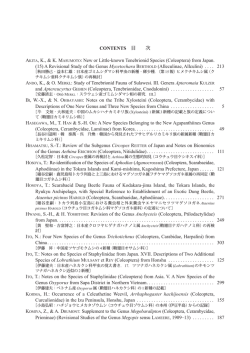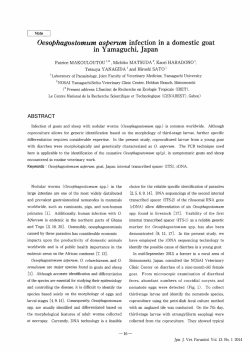
Page 1 Page 2 邸ic蠅 迦c魍iC。エ工is (C。ーe。pteraz Euiichadidae
Shinshu University Institutional Repository SOAR-IR Title Author(s) Citation Issue Date URL Rights Eulichas incisicolils (coleoptera: Eulichadidae), an important decomposer of leaf litter in Asian tropical stream communities HAYASHI, Fumio 信州大学理学部附属諏訪臨湖実験所報告 9: 25-28(1995) 1995-10 http://hdl.handle.net/10091/1967 Rep. Suwa }lydrobiot, 9' 25b-28 (IP95) Preceedings of the 7th International Symposium an River and Lake Enitirenments, fPP4, Matsumoto 25 Eulchas incisicollis (Coleoptera: Eulichadidae), an important decomposer of leaf litter in Asian tropical stream communities Fumio HAYASHI Department of Biology, Tokyo Metropolitan University, Minarniosawa 1-1. Hachioji, Tokyo, 192-03, Japan. ZN[ffRODUCTION Coleoptera is the largest order of insects, and its approximately SOOO aquatie mernbers make up one of the major groups of freshwater arthropods [1]. However, inhabitants in the swifter portions of streams and rivers are rare and, in general, small in body s±ze [1]. However, there are exceptions. A North American ptUodactylid. Stenocolus sp. is an extremeiy iarge coleopteran (14-22 mm ±n adult body kength) living in stream riffies dur±ng its larval stages [1]. In Southeast Asia, Euttchas, the oniy genus of Euiichadidae, are large coieopterans w±th aquatic iarval stages [2]. However, no information is availabie on their iarval morphology or life cycles. Xn this paper, some bionomicai data of E. incisicollis Pic, 1933 are presented. METKOPS The study site (200 ra iong) was located at a tributairy (stony stream, altitude 200 m) of the Gombak River near the Field Study Center, University of Maiaya, iocated in UXu Gombak, Selangor Darui Ehsan, MaXaysia. and was vis±ted five ℃imes: 5-11 September i992, 9-11 February 1993, 6 June 1993, 27 Septemberc-10 Octoberc 1993r and 19 March i994. The larvae were collected with a hand net (2.0 mm mesh) throughout the study site and, after the pro- thorax length (Fig. i) was measured with a slide caliper to the nearest O.05 mrn, they were reieased at each coliecting point. Stream temperatures were taken at noon one to three times at each visit. Six large larvae were reared in a laboratory aquariurn (20 X 30 em2 , 7 cm in water depth). The water was continuously aerated and kept a℃ 23-250C (14 h ligh℃: 10 h dark). Small pieces of carrot were g±ven as larval food. A giass box (7 cm in diameter) containing wet peat moss was placed in the aquarium for the larvae gx2?ugstgth x2・sxge2.gdggg2.:ege, :ill?・Esd.gg g.ggggsi:,2flge.t20,g,,gR twigs and leaves. They were also given a roughiy 10 & sugar solution containing a iittle fermented mRk. . 0n 8 October 1993t nine larvae werce fixed in 70 g ethanol immedlately after coXiection and laterc dissected. The whoie gut (foregut to hindgut) and the body were separately dried at 80eC for 12 h to estimate the dry weight ratio of gut contents to the gutted body. AIX gut contents were identifted under a binocular m±crcoscope (X20) after dissection. 26 x.ut ge L K' .t tt.as Mre '''iv'L g ;' t.t. ee bl- .eq.sckl,ew ' x. FSg. 1. Larvae (left, dorsal; center, lateral view) and adult fernales (righ℃, dorsaO of Eulichas incisicoZlis. The coin is 23.5 mm in diameter. PL: prothorax length. The density of Eulichas larvae in the study stte was estimated on 30 September 1993. rn ℃he riffles, stones were sarnpled individual!y by washing thern in a net (O.20 mva mesh) held immed±ately downs℃ream. Stones were weighed to the nearest O.Ol kg using a spning ba!ance. and their sutface areas were laterc estimated by the foxiowing equ stl.O?4532o] k w + ssg.4)O・667, where s (cra2) is the surface area of the stone and w (kg) its weight. The larval density per untt of stone surface was then calculated. RESULTS Of nine laboratory-reared larvae, only one feraale adult (Ng. 1 right) emerged after the 17-day pupal period. This female left the pupating space in the peat moss after another 11 days, and iived forc 112 days in the cage. The body was brown coioured, and 34 mm in total length and 12 mm ±n width at the widest po±nt. Eggs removed from this unmated female were white and eliipsoidal, O.70 mm (Nxx5, SE=O.Ol) long and O.58 mm (N=5, SE=O.02) wide. Larvae (Fig. ! Xeft) were found under and among stones at the center of riffles. They were brown in body coiour and had many fUamentous gUls on the ventral side of the abdomen. When stimukgxgge. tcgg ?g2t,xgeg'E.Rgd±'g;,gggg(.l.,gg"g2!.Bl,"e .x2an..k2gx% consisted of only small pieces of failen leaves which were fuliy 27 Frequency 7 05 6 ff AE v= 5 ts, mc 4 xes "o 3 ¢ sc 2 .v-, o u A 1 Ao o di -. 26 x f N ・s.・" E ts 24 es co " w co FSg. 2. E" w 22 ee ee ge @ × ov @/ g-. ee J F M A M J J A S O N D Seasonal ahanges in frequency distributions (number of individuals) of prothorax length of larval Eulichas incisicoZ2is. Samples were taken on 5-11 Septembezr 2992 (Nma23), 9-11 Februairy 1993 (N=26), 6 June 1993 (Nma44), 27 Septemberc-10 October 1993 (N=I07), and 19 March 1994 (Nm16). Annual st]rearn temperature regime is also shown on the bottofn and the Une Xs drawn at 24"C. packed from foregut to hindgut. The mean prothorax Xength of nine Xarvae used for guic coRtent analysis was 4.33 mm (range 2.75-5.60 mrn), and the mean gut/body ratio was 29.i& (range 20.5-45.3&). Annual strearu temperature was nearly constant at 240C, and all sizes of Xarvae were found throughout the year (F±g. 2). In this study, howeverc, srnaU larvae may have escaped capturce due to the coarse mesh size of the coilecting net (2.0 mm). The size of the first-instax iarvae and the numberc of instars were unknown. DXSCUSSION Adult E. incislco2Zis probably appear in all seasons, since the large larvae were collected throughout the year. The larvae inhab±ted stony niffies at a density of I.4 /rn2. They consumed dead ieaves which accumulated ±n the gut, reaching nearly 30& of their body weight. Although there are no comparetive data of other species of leaf decomposers inhabiting tropical streams, E. incisicoZlls is cons±dered to be one of most important decomposers. 28 zn East Asia, the reiative abundance of Coleoptera in stream riffle benthic communities tends to increase from ternperate to tropicai regions, and iarge-sized species such as EuZichas spp. are found onky in tropical streams [2, 4]. Lotic members of aquatic coleopteirans (Psephenidae, Pryopidae, Elmidae, Ptilodacty!±dae and so on) are generaliy detrit±vores [1] as is E. incis- ico2lis. Therefore, as fallen leaves decompose on ehe stream beds, cokeopterans probably play a more ±mportant ro!e in a tropical riffie community than in a tempeacate one. Adults of E. incisic.o22is were rnuch karger than those of the North Araerican Stenocolus sp., which is known as one of the largest riffle--dwexxing coleopterans [1]. The environment of the studied stream is charaeterized by (O constantly high teinpera-ture. (2) stabXe flow regirae because of its location in a weli preserved hUl forest, and (3) no seasonal deficiency ±n falien leaf raaterial. In such an environment, ±n contrast to ternperate s℃rearas where temperatures decrease in w±nter and fallen leaves are generaily unavailabie frora spring to summer, growth in trop±cal streams is unlnhibiiced by faUing temperatures orc food shortages. This is one possible reason why E. incisicollis has a long Zarval perlod and subsequently rnatures to a large body size. AC KNOptLEDGEMENTS I wish to thank H. S. Yong (University of Malaya) and the staff of the Field Study Center of the University of Malaya forc their kind suppert ef ℃h±s study. X am grateEuX also to M. $ato (Nagoya Women's Univexsity) for species identSfication of the aduk specimen, and Y. Okush±ma (Kurash±ki Museum of NaturaX Histo]ry) for usufu1 inforaiation regarding this spec±es. Th±s study was partly supported by the Shikata Memeriai Trust £or Nature Conservaston, Tokyo, Japan. REFERENCES 1. 2. 3. Whi℃e, D.S., Br±gham, W.U. and Doyeft, J.T.. 1984: Aquatic Coleoptera. Xn "An Xntroduction to the Aquatic Xnsects of North Aivierica" (eds. R.W. Merritt and K.W. Curnwins), pp.361437. Kendali/Hunt PublS$hing Company, Iowa. Bishop, J.E., 1973: Limnology of a Small Malayan River Sungai Gombak. 485pp. Dr. W. Junk B.V. Publishers, Whe Hague. Kayashi, F., 1988: Mfe histoiry variation in a dobsonfly, protohernies grandis (Megaloptera: Corydalidae): effects of prey availabiMty and temperature. Frceshwater Biol., 19: 205216. 4. Hayashi, F., unpublished data.
© Copyright 2025

